The GPI-Anchored Aspartyl Proteases Encoded by the YPS1 and YPS7 Genes of Candidozyma auris and Their Role Under Stress Conditions
Abstract
1. Introduction
2. Materials and Methods
2.1. Strains
2.2. In Silico Analysis
2.3. Phylogeny of C. auris Putative Yapsins
2.4. Prediction of the Secondary and Tertiary Structure of Putative Yapsins
2.5. Molecular Docking of C. auris Putative Yps1 and Yps7
2.6. Evaluation of C. auris Growth Under Different Conditions
2.7. Expression of YPS1 and YPS7 Genes by RT-qPCR
2.8. Transcriptomic Analysis of C. auris 20-1498 Under Heat Stress
2.9. Effect of Pepstatin A on the Microscopic Morphology of C. auris
3. Results
3.1. C. auris Presents a Family of YPS Multigene Encoding Putative Yapsins
3.2. Yps1 and Yps7 of C. auris are Orthologous to the Yapsins of C. albicans, C. glabrata (Nakaesomyces glabratus), and S. cerevisiae
3.3. The C. auris Proteins Yps1 and Yps7 Present a Secondary and Tertiary Structure of Aspartyl Proteases, Capable of Binding to the Specific Inhibitor Pepstatin A and Interacting with Other Proteins
3.4. Growth of C. auris CJ97 and 20-1498 in the Presence of Different Stressor Compounds
3.5. Differential Expression of YPS1 and YPS7 Genes Under Different Stress Conditions
3.6. Transcriptional Response of C. auris Strain 20-1498 Under Heat Stress
3.7. Effect of Pepstatin A on the Microscopic Morphology of C. auris 20-1498
4. Discussion
Supplementary Materials
Author Contributions
Funding
Institutional Review Board Statement
Informed Consent Statement
Data Availability Statement
Acknowledgments
Conflicts of Interest
References
- Hube, B.; Naglik, J. Candida albicans proteinases: Resolving the mystery of a gene family. Microbiology 2001, 147, 1997–2005. [Google Scholar] [CrossRef]
- Albrecht, A.; Felk, A.; Pichova, I.; Naglik, J.R.; Schaller, M.; de Groot, P.; MacCallum, D.; Odds, F.C.; Schäfer, W.; Michel, M.; et al. Glycosylphosphatidylinositol-anchored proteases of Candida albicans target proteins necessary for both cellular processes and host-pathogen interactions. J. Biol. Chem. 2006, 281, 688–694. [Google Scholar] [CrossRef]
- Kaur, R.; Ma, B.; Cormack, B.P. A family of glycosylphosphatidylinositol-linked aspartyl proteases is required for virulence of Candida glabrata. Proc. Natl. Acad. Sci. USA 2007, 104, 7628–7633. [Google Scholar] [CrossRef]
- Schild, L.; Heyken, A.; de Groot, P.W.; Hiller, E.; Mock, M.; de Koster, C.; Horn, U.; Rupp, S.; Hube, B. Proteolytic cleavage of covalently linked cell wall proteins by Candida albicans Sap9 and Sap10. Eukaryot. Cell 2011, 10, 98–109. [Google Scholar] [CrossRef]
- Egel-Mitani, M.; Flygenring, H.P.; Hansen, M.T. A novel aspartyl protease allowing KEX2-independent MF alpha propheromone processing in yeast. Yeast 1990, 6, 127–137. [Google Scholar] [CrossRef] [PubMed]
- Olsen, V.; Loh, Y.P. In vivo processing of nonanchored Yapsin 1 (Yap3p). Arch. Biochem. Biophys. 2000, 375, 315–321. [Google Scholar] [CrossRef] [PubMed]
- Bourbonnais, Y.; Ash, J.; Daigle, M.; Thomas, D.Y. Isolation and characterization of S. cerevisiae mutants defective in somatostatin expression: Cloning and functional role of a yeast gene encoding an aspartyl protease in precursor processing at monobasic cleavage sites. EMBO J. 1993, 12, 285–294. [Google Scholar] [CrossRef]
- Gagnon-Arsenault, I.; Tremblay, J.; Bourbonnais, Y. Fungal yapsins and cell wall: A unique family of aspartic peptidases for a distinctive cellular function. FEMS Yeast Res. 2006, 6, 966–978. [Google Scholar] [CrossRef] [PubMed]
- de Groot, P.W.J.; Brandt, B.W. ProFASTA: A pipeline web server for fungal protein scanning with integration of cell surface prediction software. Fungal Genet. Biol. 2012, 49, 173–179. [Google Scholar] [CrossRef]
- Rawlings, N.D.; Salvesen, G. Handbook of Proteolytic Enzymes; Academic Press: San Diego, CA, USA, 2013. [Google Scholar]
- Parra-Ortega, B.; Cruz-Torres, H.; Villa-Tanaca, L.; Hernandez-Rodriguez, C. Phylogeny and evolution of the aspartyl protease family from clinically relevant Candida species. Mem. Inst. Oswaldo Cruz. 2009, 104, 505–512. [Google Scholar] [CrossRef]
- Satoh, K.; Makimura, K.; Hasumi, Y.; Nishiyama, Y.; Uchida, K.; Yamaguchi, H. Candida auris sp. nov., a novel ascomycetous yeast isolated from the external ear canal of an inpatient in a Japanese hospital. Microbiol. Immunol. 2009, 53, 41–44. [Google Scholar] [CrossRef] [PubMed]
- Santana, D.J.; Zhao, G.; O’Meara, T.R. The many faces of Candida auris: Phenotypic and strain variation in an emerging pathogen. PLoS Pathog. 2024, 20, e1012011. [Google Scholar] [CrossRef]
- Yue, H.; Bing, J.; Zheng, Q.; Zhang, Y.; Hu, T.; Du, H.; Wang, H.; Huang, G. Filamentation in Candida auris, an emerging fungal pathogen of humans: Passage through the mammalian body induces a heritable phenotypic switch. Emerg. Microbes Infect. 2018, 7, 188. [Google Scholar] [CrossRef]
- Casadevall, A.; Kontoyiannis, D.P.; Robert, V. On the emergence of Candida auris: Climate change, azoles, swamps, and birds. mBio 2019, 10, e01397-19. [Google Scholar] [CrossRef]
- Arora, P.; Singh, P.; Wang, Y.; Yadav, A.; Pawar, K.; Singh, A.; Padmavati, G.; Xu, J.; Chowdhary, A. Environmental isolation of Candida auris from the coastal wetlands of Andaman Islands, India. mBio 2021, 12, e03181-20. [Google Scholar] [CrossRef]
- Lockhart, S.R.; Chowdhary, A.; Gold, J.A. The rapid emergence of antifungal-resistant human-pathogenic fungi. Nat. Rev. Microbiol. 2023, 21, 818–832. [Google Scholar] [CrossRef]
- Horton, M.V.; Johnson, C.J.; Zarnowski, R.; Andes, B.D.; Schoen, T.J.; Kernien, J.F.; Lowman, D.; Kruppa, M.D.; Ma, Z.; Williams, D.L.; et al. Candida auris cell wall mannosylation contributes to neutrophil evasion through pathways divergent from Candida albicans and Candida glabrata. mSphere 2021, 6, e0040621. [Google Scholar] [CrossRef] [PubMed]
- Dakalbab, S.; Hamdy, R.; Holigová, P.; Abuzaid, E.J.; Abu-Qiyas, A.; Lashine, Y.; Mohammad, M.G.; Soliman, S.S. Uniqueness of Candida auris cell wall in morphogenesis, virulence, resistance, and immune evasion. Microbiol. Res. 2024, 286, 127797. [Google Scholar] [CrossRef] [PubMed]
- Alvarado, M.; Gómez-Navajas, J.A.; Blázquez-Muñoz, M.T.; Gómez-Molero, E.; Fernández-Sánchez, S.; Eraso, E.; Munro, C.A.; Valentín, E.; Mateo, E.; de Groot, P.W.J. The good, the bad, and the hazardous: Comparative genomic analysis unveils cell wall features in the pathogen Candidozyma auris typical for both baker’s yeast and Candida. FEMS Yeast Res. 2024, 24, foae039. [Google Scholar] [CrossRef]
- Pezzotti, G.; Kobara, M.; Nakaya, T.; Imamura, H.; Fujii, T.; Miyamoto, N.; Adachi, T.; Yamamoto, T.; Kanamura, N.; Ohgitani, E.; et al. Raman metabolomics of Candida auris clades: Profiling and barcode identification. Int. J. Mol. Sci. 2022, 23, 11736. [Google Scholar] [CrossRef]
- Kim, J.S.; Lee, K.T.; Bahn, Y.S. Secreted aspartyl protease 3 regulated by the Ras/cAMP/PKA pathway promotes the virulence of Candida auris. Front. Cell. Infect. Microbiol. 2023, 13, 1257897. [Google Scholar] [CrossRef]
- Krysan, D.J.; Ting, E.L.; Abeijon, C.; Kroos, L.; Fuller, R.S. Yapsins are a family of aspartyl proteases required for cell wall integrity in Saccharomyces cerevisiae. Eukaryot. Cell 2005, 4, 1364–1374. [Google Scholar] [CrossRef]
- Askari, F.; Rasheed, M.; Kaur, R. The yapsin family of aspartyl proteases regulate glucose homeostasis in Candida glabrata. J. Biol. Chem. 2022, 298, 101593. [Google Scholar] [CrossRef] [PubMed]
- Ruiz Gaitán, A.C.; Moret, A.; López Hontangas, J.L.; Molina, J.M.; Aleixandre López, A.I.; Cabezas, A.H.; Mollar Maseres, J.; Arcas, R.C.; Gómez Ruiz, M.D.; Chiveli, M.Á.; et al. Nosocomial fungemia by Candida auris: First four reported cases in continental Europe. Rev. Iberoam. Micol. 2017, 34, 23–27. [Google Scholar] [CrossRef] [PubMed]
- Caballero, U.; Eraso, E.; Quindós, G.; Jauregizar, N. In vitro interaction and killing-kinetics of amphotericin B combined with anidulafungin or caspofungin against Candida auris. Pharmaceutics 2021, 13, 1333. [Google Scholar] [CrossRef]
- Ayala-Gaytán, J.J.; Montoya, A.M.; Martínez-Resendez, M.F.; Guajardo-Lara, C.E.; Treviño-Rangel, R.D.J.; Salazar-Cavazos, L.; Llaca-Díaz, J.M.; González, G.M. First case of Candida auris isolated from the bloodstream of a Mexican patient with serious gastrointestinal complications from severe endometriosis. Infection 2021, 49, 523–525. [Google Scholar] [CrossRef]
- Casimiro-Ramos, A.; Bautista-Crescencio, C.; Vidal-Montiel, A.; González, G.M.; Hernández-García, J.A.; Hernández-Rodríguez, C.; Villa-Tanaca, L. Comparative genomics of the first resistant Candida auris strain isolated in Mexico: Phylogenomic and pan-genomic analysis and mutations associated with antifungal resistance. J. Fungi 2024, 10, 392. [Google Scholar] [CrossRef]
- Teufel, F.; Almagro Armenteros, J.J.; Johansen, A.R.; Gíslason, M.H.; Pihl, S.I.; Tsirigos, K.D.; Winther, O.; Brunak, S.; von Heijne, G.; Nielsen, H. SignalP 6.0 predicts all five types of signal peptides using protein language models. Nat. Biotechnol. 2022, 40, 1023–1025. [Google Scholar] [CrossRef]
- Gíslason, M.H.; Nielsen, H.; Almagro-Armenteros, J.J.; Johansen, A. Prediction of GPI-Anchored proteins with pointer neural networks. Curr. Res. Biotechnol. 2021, 3, 6–13. [Google Scholar] [CrossRef]
- Monteiro, P.T.; Oliveira, J.; Pais, P.; Antunes, M.; Palma, M.; Cavalheiro, M.; Teixeira, M.C. YEASTRACT+: A portal for cross-species comparative genomics of transcription regulation in yeasts. Nucleic Acids Res. 2020, 48, D642–D649. [Google Scholar] [CrossRef] [PubMed]
- Campanella, J.J.; Bitincka, L.; Smalley, J. MatGAT: An application that generates similarity/identity matrices using protein or DNA sequences. BMC Bioinform. 2003, 4, 29. [Google Scholar] [CrossRef]
- Larkin, M.A.; Blackshields, G.; Brown, N.P.; Chenna, R.; McGettigan, P.A.; McWilliam, H.; Valentin, F.; Wallace, I.M.; Wilm, A.; Lopez, R.; et al. Clustal W and Clustal X version 2.0. Bioinformatics 2007, 23, 2947–2948. [Google Scholar] [CrossRef] [PubMed]
- Nguyen, L.T.; Schmidt, H.A.; von Haeseler, A.; Minh, B.Q. IQ-TREE: A fast and effective stochastic algorithm for estimating maximum-likelihood phylogenies. Mol. Biol. Evol. 2015, 32, 268–274. [Google Scholar] [CrossRef]
- Robert, X.; Gouet, P. Deciphering key features in protein structures with the new ENDscript server. Nucleic Acids Res. 2014, 42, W320–W324. [Google Scholar] [CrossRef]
- Waterhouse, A.; Bertoni, M.; Bienert, S.; Studer, G.; Tauriello, G.; Gumienny, R.; Heer, F.T.; de Beer, T.A.P.; Rempfer, C.; Bordoli, L.; et al. SWISS-MODEL: Homology modelling of protein structures and complexes. Nucleic Acids Res. 2018, 46, W296–W303. [Google Scholar] [CrossRef]
- Hanwell, M.D.; Curtis, D.E.; Lonie, D.C.; Vandermeersch, T.; Zurek, E.; Hutchison, G.R. Avogadro: An advanced semantic chemical editor, visualization, and analysis platform. J. Cheminform. 2012, 4, 17. [Google Scholar] [CrossRef]
- Pettersen, E.F.; Goddard, T.D.; Huang, C.C.; Couch, G.S.; Greenblatt, D.M.; Meng, E.C.; Ferrin, T.E. UCSF Chimera—A visualization system for exploratory research and analysis. J. Comput. Chem. 2004, 25, 1605–1612. [Google Scholar] [CrossRef]
- Eberhardt, J.; Santos-Martins, D.; Tillack, A.F.; Forli, S. AutoDock Vina 1.2.0: New docking methods, expanded force field, and python bindings. J. Chem. Inf. Model. 2021, 61, 3891–3898. [Google Scholar] [CrossRef] [PubMed]
- Yan, Y.; Tao, H.; He, J.; Huang, S.-Y. The HDOCK server for integrated protein-protein docking. Nat. Protoc. 2020, 15, 1829–1852. [Google Scholar] [CrossRef]
- Schmitt, M.E.; Brown, T.A.; Trumpower, B.L. A rapid and simple method for preparation of RNA from Saccharomyces cerevisiae. Nucleic Acids Res. 1990, 18, 3091–3092. [Google Scholar] [CrossRef] [PubMed]
- Livak, K.J.; Schmittgen, T.D. Analysis of relative gene expression data using real-time quantitative PCR and the 2−ΔΔCT method. Methods 2001, 25, 402–408. [Google Scholar] [CrossRef]
- Carolus, H.; Pierson, S.; Muñoz, J.F.; Subotić, A.; Cruz, R.B.; Cuomo, C.A.; Van Dijck, P. Genome-wide analysis of experimentally evolved Candida auris reveals multiple novel mechanisms of multidrug resistance. mBio 2021, 12, e03333-20. [Google Scholar] [CrossRef]
- Hager, C.L.; Larkin, E.L.; Long, L.; Zohra Abidi, F.; Shaw, K.J.; Ghannoum, M.A. In vitro and in vivo evaluation of the antifungal activity of APX001A/APX001 against Candida auris. Antimicrob. Agents Chemother. 2018, 62, e02319-17. [Google Scholar] [CrossRef]
- Bras, G.; Satala, D.; Juszczak, M.; Kulig, K.; Wronowska, E.; Bednarek, A.; Karkowska-Kuleta, J. Secreted aspartic proteinases: Key factors in Candida infections and host-pathogen interactions. Int. J. Mol. Sci. 2024, 25, 4775. [Google Scholar] [CrossRef]
- Gagnon-Arsenault, I.; Parisé, L.; Tremblay, J.; Bourbonnais, Y. Activation mechanism, functional role and shedding of glycosylphosphatidylinositol-anchored Yps1p at the Saccharomyces cerevisiae cell surface. Mol. Microbiol. 2008, 69, 982–993. [Google Scholar] [CrossRef]
- Rasheed, M.; Battu, A.; Kaur, R. Aspartyl proteases in Candida glabrata are required for suppression of the host innate immune response. J. Biol. Chem. 2018, 293, 6410–6433. [Google Scholar] [CrossRef] [PubMed]
- Olsen, V.; Cawley, N.X.; Brandt, J.; Egel-Mitani, M.; Loh, Y.P. Identification and characterization of Saccharomyces cerevisiae yapsin 3, a new member of the yapsin family of aspartic proteases encoded by the YPS3 gene. Biochem. J. 1999, 339, 407–411. [Google Scholar] [CrossRef] [PubMed]
- Dubé, A.K.; Bélanger, M.; Gagnon-Arsenault, I.; Bourbonnais, Y. N-terminal entrance loop of yeast Yps1 and O-glycosylation of substrates are determinant factors controlling the shedding activity of this GPI-anchored endopeptidase. BMC Microbiol. 2015, 15, 50. [Google Scholar] [CrossRef] [PubMed]
- Zhang, Y. Progress and challenges in protein structure prediction. Curr. Opin. Struct. Biol. 2008, 18, 342–348. [Google Scholar] [CrossRef]
- Shimizu, N.; Katagiri, T.; Matsumoto, A.; Matsuda, Y.; Arai, H.; Sasaki, N.; Abe, K.; Katase, T.; Ishida, H.; Kusumoto, K.I.; et al. Oryzapsins, the orthologs of yeast yapsin in Aspergillus oryzae, affect ergosterol synthesis. Appl. Microbiol. Biotechnol. 2021, 105, 8481–8494. [Google Scholar] [CrossRef]
- Silva, R.D.S.; Segura, W.D.; Oliveira, R.S.; Xander, P.; Batista, W.L. Characterization of aspartic proteases from Paracoccidioides brasiliensis and their role in fungal thermo-dimorphism. J. Fungi 2023, 9, 375. [Google Scholar] [CrossRef]
- Clark-Flores, D.; Vidal-Montiel, A.; Mondragón-Flores, R.; Valentín-Gómez, E.; Hernández-Rodríguez, C.; Juárez-Montiel, M.; Villa-Tanaca, L. Vacuolar proteases of Candida auris from clades III and IV and their relationship with autophagy. J. Fungi 2025, 11, 388. [Google Scholar] [CrossRef]
- Day, A.M.; McNiff, M.M.; da Silva Dantas, A.; Gow, N.A.; Quinn, J. Hog1 regulates stress tolerance and virulence in the emerging fungal pathogen Candida auris. mSphere 2018, 3, e00506-18. [Google Scholar] [CrossRef]
- Gibbs, E.; Hsu, J.; Barth, K.; Goss, J.W. Characterization of the nanomechanical properties of the fission yeast (Schizosaccharomyces pombe) cell surface by atomic force microscopy. Yeast 2021, 38, 480–492. [Google Scholar] [CrossRef]
- Bairwa, G.; Rasheed, M.; Taigwal, R.; Sahoo, R.; Kaur, R. GPI (glycosylphosphatidylinositol)-linked aspartyl proteases regulate vacuole homoeostasis in Candida glabrata. Biochem. J. 2014, 458, 323–334. [Google Scholar] [CrossRef]
- Shivarathri, R.; Chauhan, M.; Datta, A.; Das, D.; Karuli, A.; Aptekmann, A.; Chauhan, N. The Candida auris Hog1 MAP kinase is essential for the colonization of murine skin and intradermal persistence. mBio 2024, 15, e02748-24. [Google Scholar] [CrossRef]
- Banda-Flores, I.A.; Torres-Tirado, D.; Mora-Montes, H.M.; Pérez-Flores, G.; Pérez-García, L.A. Resilience in resistance: The role of cell wall integrity in multidrug-resistant Candida. J. Fungi 2025, 11, 271. [Google Scholar] [CrossRef] [PubMed]
- Cortés-Acosta, E.; Ibarra, J.A.; Ramírez-Saad, H.; Vargas-Mendoza, C.F.; Villa-Tanaca, L.; Hernández-Rodríguez, C. Polymorphism in the regulatory regions of genes CgYPS1 and CgYPS7 encoding yapsins in Candida glabrata is associated with changes in expression levels. FEMS Yeast Res. 2017, 17, fox077. [Google Scholar] [CrossRef] [PubMed][Green Version]
- Mercurio, K.; Singh, D.; Walden, E.; Baetz, K. Global analysis of Saccharomyces cerevisiae growth in mucin. G3 2021, 11, jkab294. [Google Scholar] [CrossRef] [PubMed]
- Jenull, S.; Tscherner, M.; Kashko, N.; Shivarathri, R.; Stoiber, A.; Chauhan, M.; Petryshyn, A.; Chauhan, N.; Kuchler, K. Transcriptome signatures predict phenotypic variations of Candida auris. Front. Cell. Infect. Microbiol. 2021, 11, 662563. [Google Scholar] [CrossRef]
- Xiao, W.; Zhou, H.; Huang, J.; Xin, C.; Zhang, J.; Wen, H.; Song, Z. Comparative analyses of the biological characteristics, fluconazole resistance, and heat adaptation mechanisms of Candida auris and members of the Candida haemulonii complex. Appl. Environ. Microbiol. 2025, 91, e02406-24. [Google Scholar] [CrossRef]
- Zhang, T.; Lin, Y.; Zhang, Z.; Wang, Z.; Zeng, F.; Wang, Q. Roles and applications of autophagy in guarding against environmental stress and DNA damage in Saccharomyces cerevisiae. FEBS J. 2025, 1–26. [Google Scholar] [CrossRef] [PubMed]
- Xiao, W.; Zhang, J.; Huang, J.; Xin, C.; Li, M.J.; Song, Z. Response and regulatory mechanisms of heat resistance in pathogenic fungi. Appl. Microbiol. Biotechnol. 2022, 106, 5415–5431. [Google Scholar] [CrossRef] [PubMed]
- Ikezaki, S.; Cho, T.; Nagao, J.I.; Tasaki, S.; Yamaguchi, M.; Arita-Morioka, K.I.; Yasumatsu, K.; Chibana, H.; Ikebe, T.; Tanaka, Y. Mild heat stress affects on the cell wall structure in Candida albicans biofilm. Med. Mycol. J. 2019, 60, 29–37. [Google Scholar] [CrossRef]
- Vadaie, N.; Dionne, H.; Akajagbor, D.S.; Nickerson, S.R.; Krysan, D.J.; Cullen, P.J. Cleavage of the signaling mucin Msb2 by the aspartyl protease Yps1 is required for MAPK activation in yeast. J. Cell Biol. 2008, 181, 1073–1081. [Google Scholar] [CrossRef]
- Miller, K.A.; DiDone, L.; Krysan, D.J. Extracellular secretion of overexpressed glycosylphosphatidylinositol-linked cell wall protein Utr2/Crh2p as a novel protein quality control mechanism in Saccharomyces cerevisiae. Eukaryot. Cell 2010, 9, 1669–1679. [Google Scholar] [CrossRef][Green Version]
- Julius, D.; Schekman, R.; Thorner, J. Glycosylation and processing of prepro-α-factor through the yeast secretory pathway. Cell 1984, 36, 309–318. [Google Scholar] [CrossRef]
- Sievi, E.; Suntio, T.; Makarow, M. Proteolytic function of GPI-anchored plasma membrane protease Yps1p in the yeast vacuole and Golgi. Traffic 2001, 2, 896–907. [Google Scholar] [CrossRef] [PubMed]
- Jiménez-Gutiérrez, E.; Alegría-Carrasco, E.; Sellers-Moya, Á.; Molina, M.; Martín, H. Not just the wall: The other ways to turn the yeast CWI pathway on. Int. Microbiol. 2020, 23, 107–119. [Google Scholar] [CrossRef]
- Ribeiro, R.A.; Bourbon-Melo, N.; Sá-Correia, I. The cell wall and the response and tolerance to stresses of biotechnological relevance in yeasts. Front. Microbiol. 2022, 13, 953479. [Google Scholar] [CrossRef]
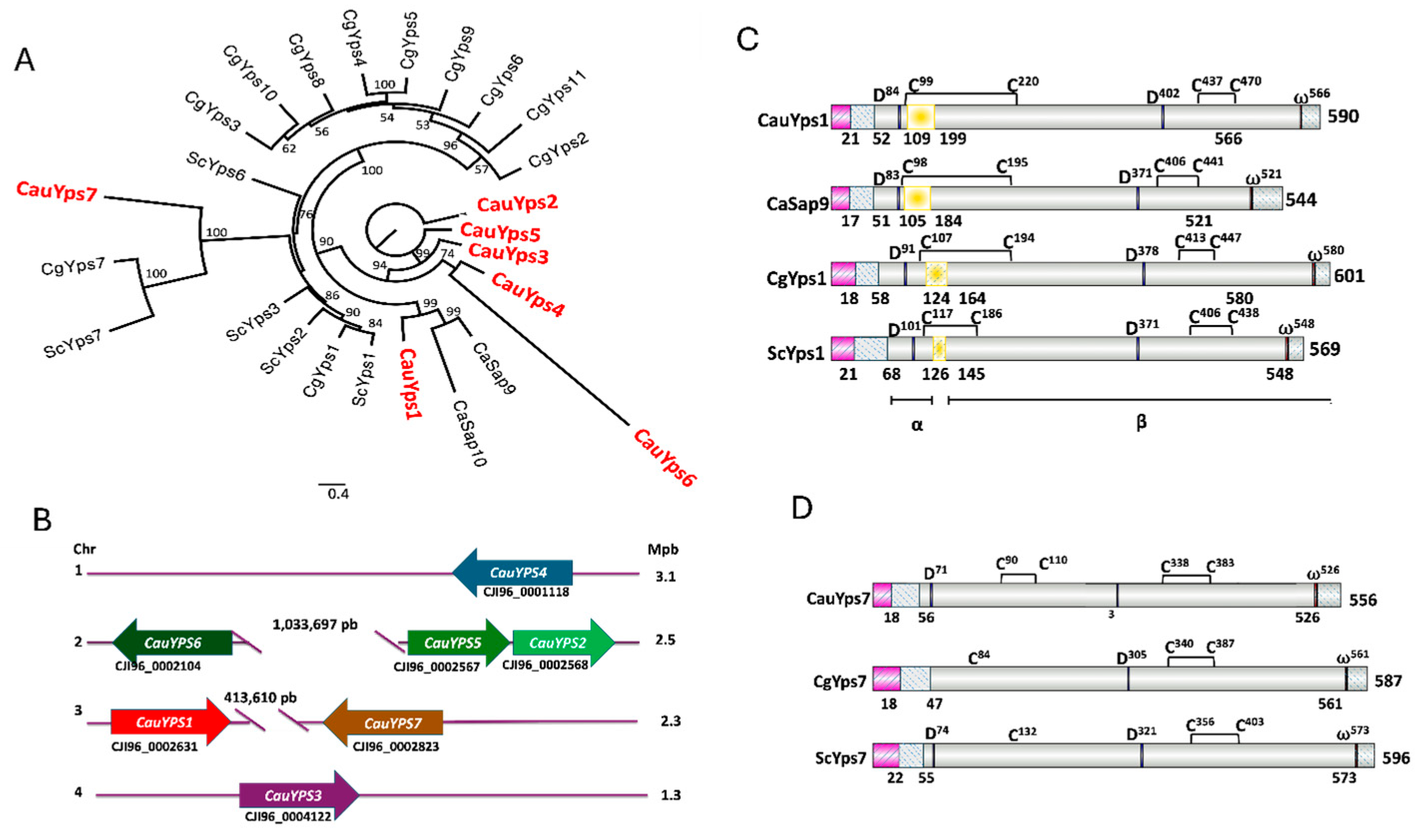
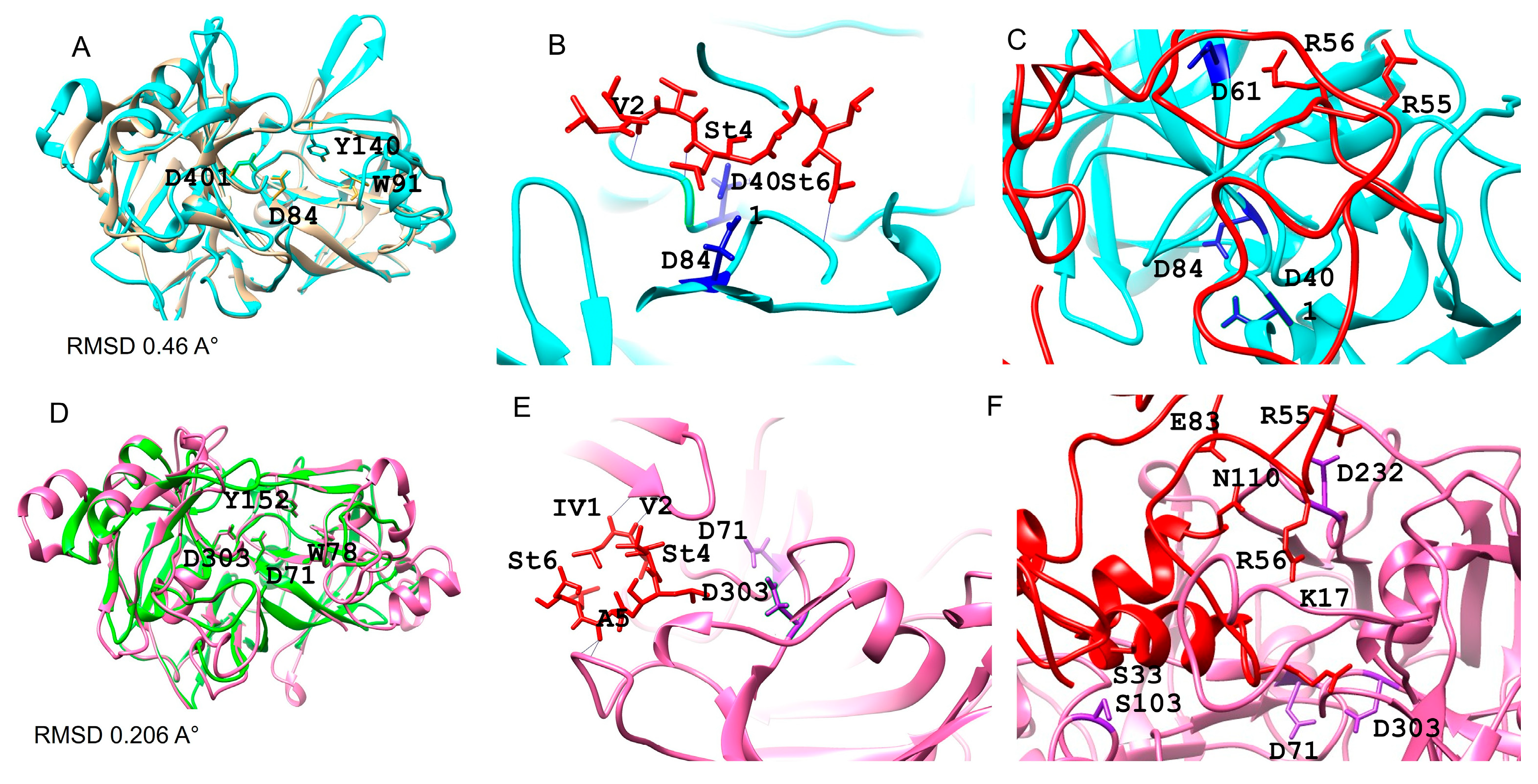
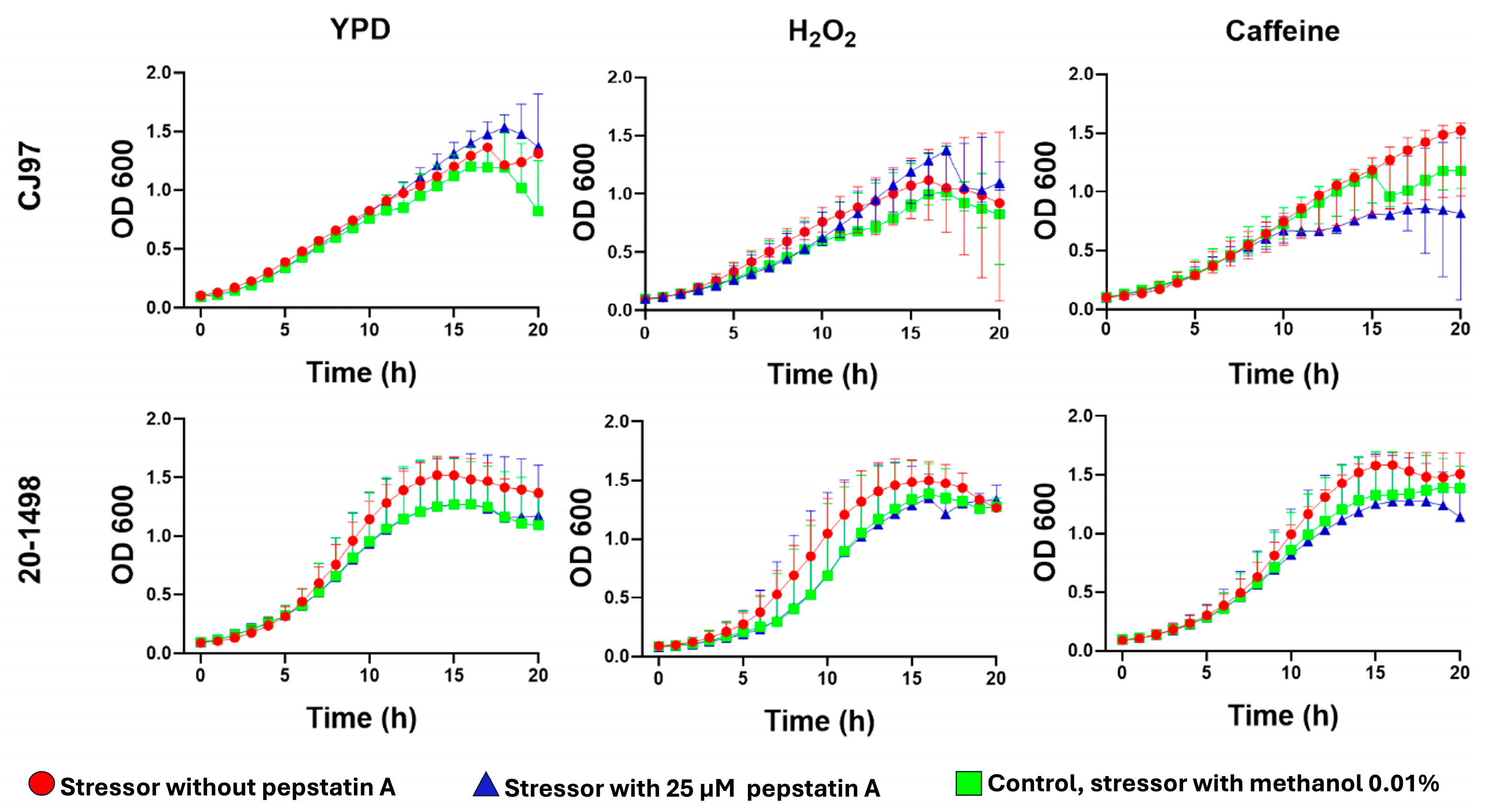


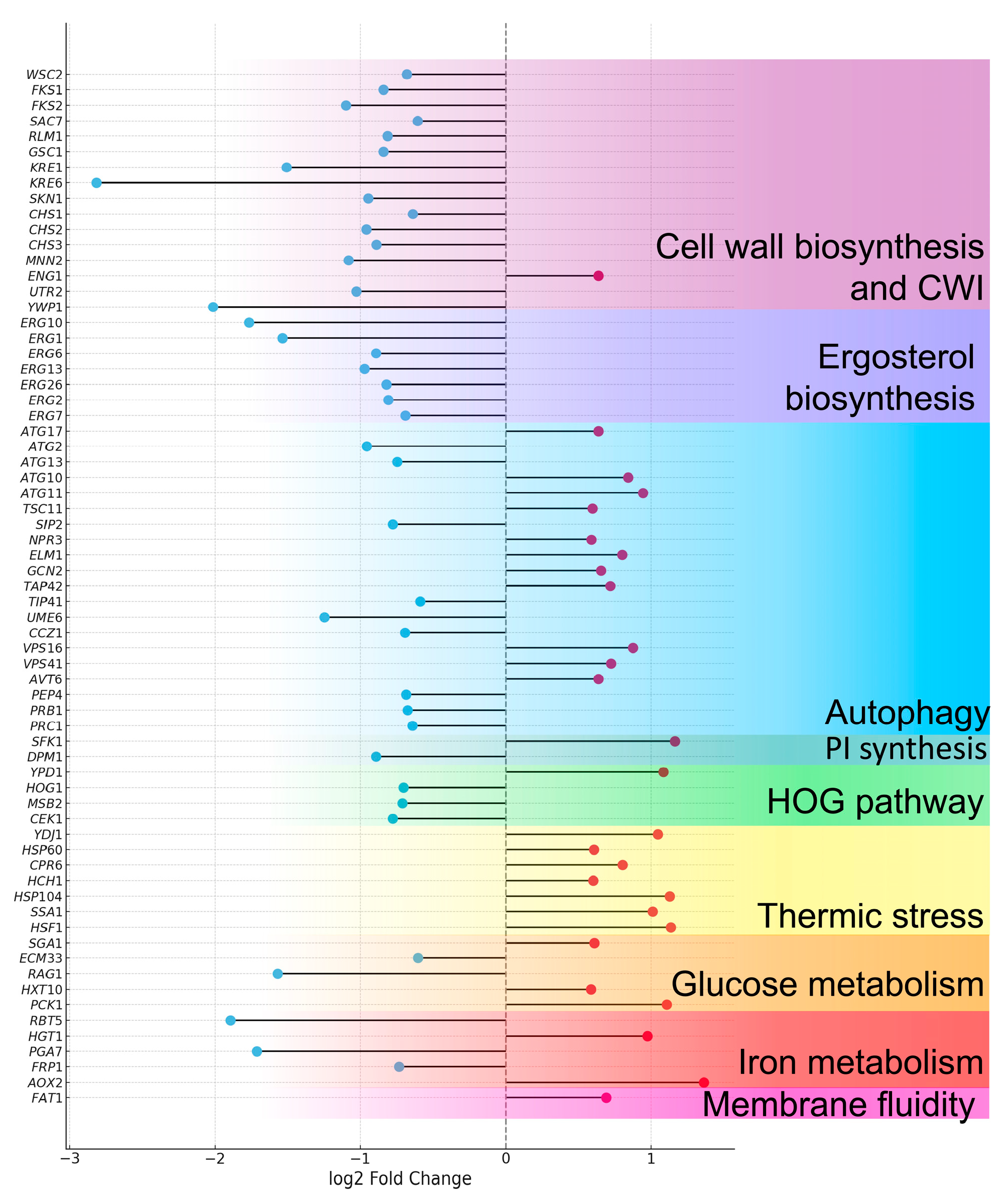
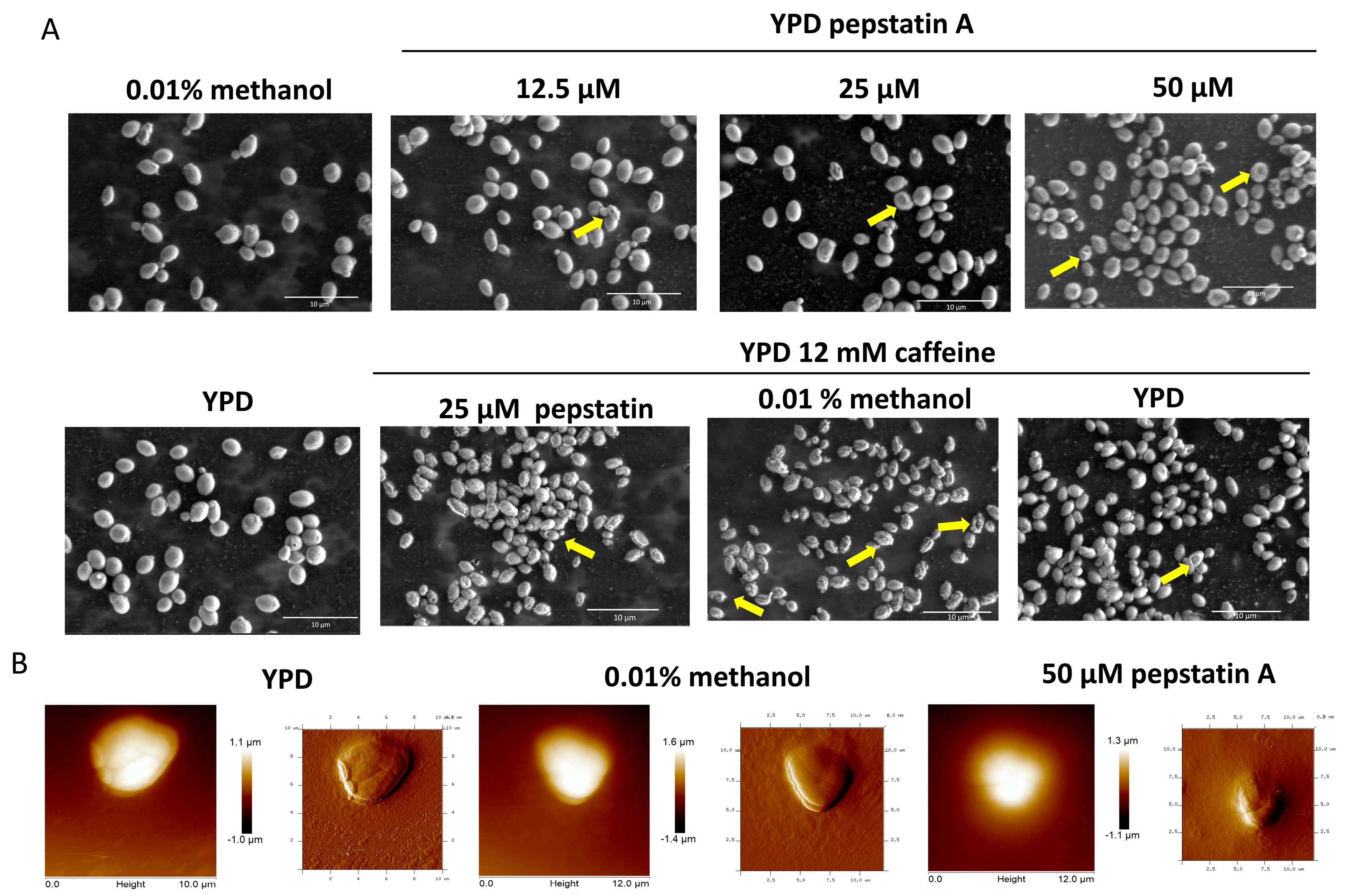
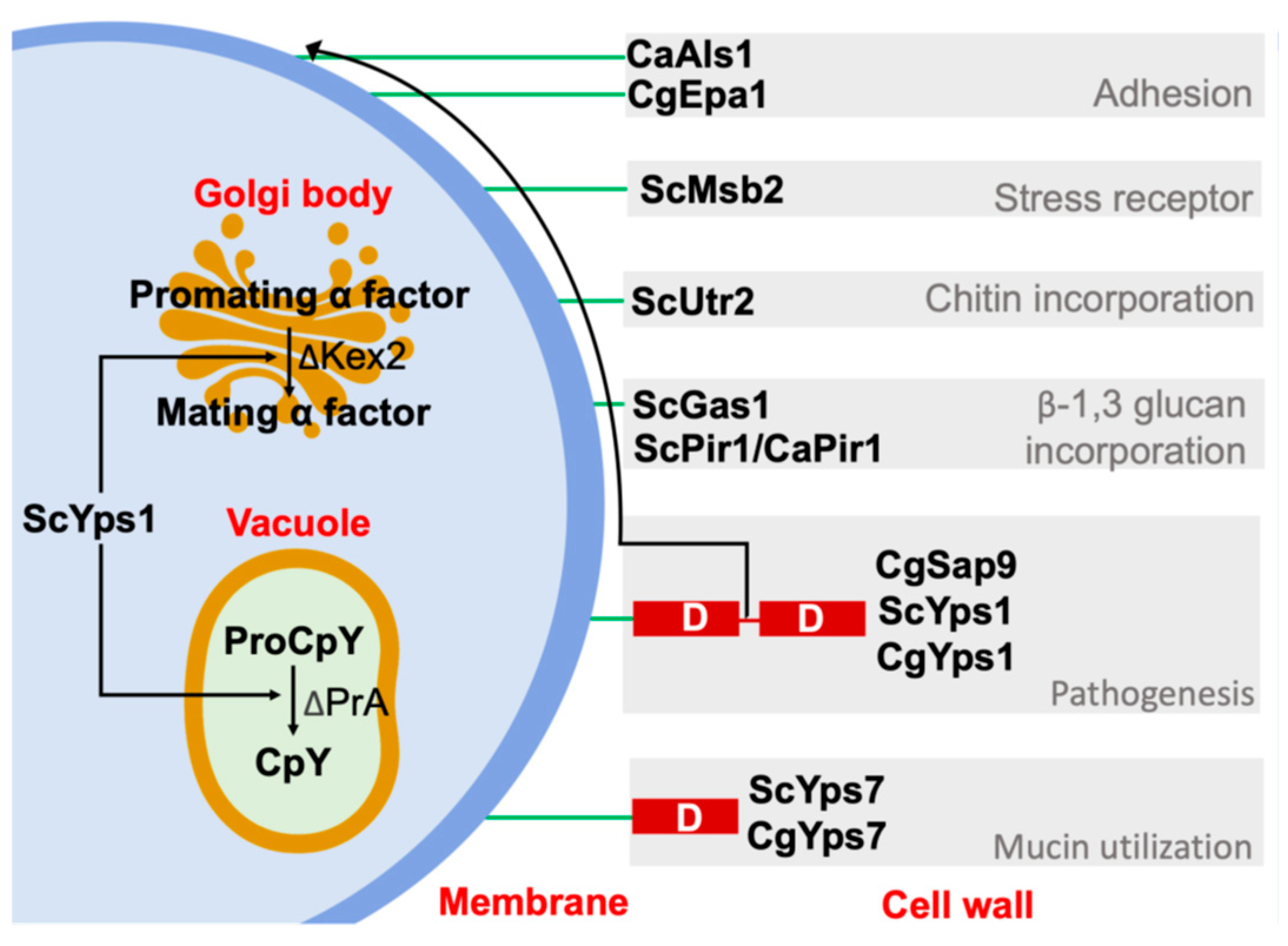
Disclaimer/Publisher’s Note: The statements, opinions and data contained in all publications are solely those of the individual author(s) and contributor(s) and not of MDPI and/or the editor(s). MDPI and/or the editor(s) disclaim responsibility for any injury to people or property resulting from any ideas, methods, instructions or products referred to in the content. |
© 2025 by the authors. Licensee MDPI, Basel, Switzerland. This article is an open access article distributed under the terms and conditions of the Creative Commons Attribution (CC BY) license (https://creativecommons.org/licenses/by/4.0/).
Share and Cite
Vidal-Montiel, A.; Clark-Flores, D.; Valentín-Gómez, E.; Luna-Arias, J.P.; Rosales-Cruz, E.; Hernández-Rodríguez, C.; Villa-Tanaca, L.; Juárez-Montiel, M. The GPI-Anchored Aspartyl Proteases Encoded by the YPS1 and YPS7 Genes of Candidozyma auris and Their Role Under Stress Conditions. J. Fungi 2025, 11, 573. https://doi.org/10.3390/jof11080573
Vidal-Montiel A, Clark-Flores D, Valentín-Gómez E, Luna-Arias JP, Rosales-Cruz E, Hernández-Rodríguez C, Villa-Tanaca L, Juárez-Montiel M. The GPI-Anchored Aspartyl Proteases Encoded by the YPS1 and YPS7 Genes of Candidozyma auris and Their Role Under Stress Conditions. Journal of Fungi. 2025; 11(8):573. https://doi.org/10.3390/jof11080573
Chicago/Turabian StyleVidal-Montiel, Alvaro, Daniel Clark-Flores, Eulogio Valentín-Gómez, Juan Pedro Luna-Arias, Erika Rosales-Cruz, César Hernández-Rodríguez, Lourdes Villa-Tanaca, and Margarita Juárez-Montiel. 2025. "The GPI-Anchored Aspartyl Proteases Encoded by the YPS1 and YPS7 Genes of Candidozyma auris and Their Role Under Stress Conditions" Journal of Fungi 11, no. 8: 573. https://doi.org/10.3390/jof11080573
APA StyleVidal-Montiel, A., Clark-Flores, D., Valentín-Gómez, E., Luna-Arias, J. P., Rosales-Cruz, E., Hernández-Rodríguez, C., Villa-Tanaca, L., & Juárez-Montiel, M. (2025). The GPI-Anchored Aspartyl Proteases Encoded by the YPS1 and YPS7 Genes of Candidozyma auris and Their Role Under Stress Conditions. Journal of Fungi, 11(8), 573. https://doi.org/10.3390/jof11080573






